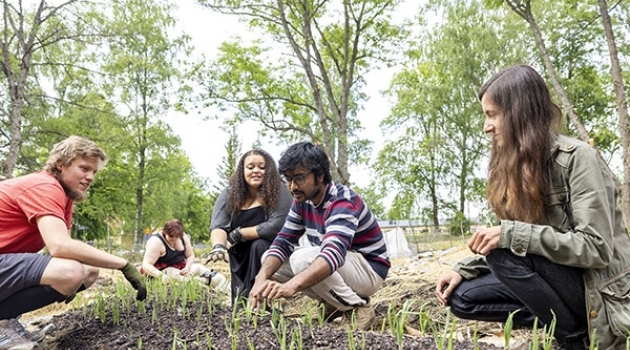Climate-smart food grown on campus here
Uppsala University Campus Garden is a project which aims to build a garden to grow food on Uppsala University campus with the goal of reducing the University's climate impact in terms of carbon emissions.
“We are creating the garden on the previously unutilised space at Villavägen 14, using recycled materials and with solutions that produce zero waste”, says Sagnik Sinha Roy and Otilia Björndahl João, project leaders.
They are inspired by permaculture principles and the aim is to integrate the garden with existing ecosystems.
“We are hoping to involve and engage different actors and levels of the University and the larger society to promote sustainable awareness, reflection and community. The aims of the garden are thus both ecological and social, utilising our multidisciplinary background.”
Sagnik Sinha Roy and Otilia Björndahl João met last summer (2020) when they were volunteering at Flogsta Food – a community garden by the Flogsta Park. They had been talking about how many unused lawns there are in Uppsala, not least around campus, heard about Uppsala University´s ‘climate pot’, decided to send in an application with the idea of a community garden – and received the funding.
“What had begun as conversations over gardening sessions then turned into something real, says Sagnik Sinha Roy.
In January, they invited volunteers to join the planning process. In March, their employment at the Climate Change Leadership node (CCL) started, and in April they had their first day´s work in the garden.
This is part of a collaboration with Akademiska Hus, which is lending the land free of charge - was this a prerequisite?
“ When we learned that Akademiska Hus owned the land, we got in touch with them and presented our project. They are working to increase biodiversity in the area and value the green spaces around the campus as part of the knowledge environment. They also provided land and funding for a similar project at the SLU campus, “Ultuna Permaculture”, so they let us use the land for free.”
SEK 187,000 from the climate pot, will cover all costs involved in this project. CCL has also contributed with funding.
How would you like to describe a community garden?
“A community garden can mean a lot of things.”
“The community garden gives us a chance to come together and nurture the environment we exist in Especially during the pandemic, a lot of us have missed having a safe space to gather and being able to be outdoors and grow food at the same time.
“We were hoping to get a broad variety of experiences among our volunteers and we are proud to say that we have achieved that with a variety of ages, geographical origins, languages, educational backgrounds, etc. We often arrange potluck lunches, with foods from all around the world. Having such a diverse community, we are also talking about arranging language cafes to help people learn different languages.”
The garden should also be based on permaculture principles – could you explain what that means?
“Permaculture is a framework that assists us in planning. Some guiding words are integration, diversity and closed systems. Being inspired by permaculture principles has meant that we work a lot on observing and getting to know the place we are working with, to take the surrounding environment and local conditions into account when planting – to work with rather than against that environment. We look for regenerative solutions that benefit people as well as the earth, creating circular systems, using recycled materials and producing no waste”.
“We work to understand how we can best capture and store energy and use resources creatively and also look for a diversity of crops and different ways to benefit the surrounding eco system.”
One point is to look to nature for solutions in the garden, trying to mimic what happens in the forest for example.
Can you give some examples of plants that will be planted here?
“We will be growing both annuals and perennials and hope to create a garden with a wide variety of crops, where there is something to eat for many months of the year: We have already planted onions, carrots, peas, pumpkins and potatoes for example and cabbage, beans, corn and much more. For perennial crops there are for example, currant bushes, raspberries cherries, medlar and chervil. We are also talking about growing mushrooms.”
What will be built up besides plants?
“We will be making a few social spaces in the garden, with furniture made out of old loading pallets. We also plan to make an insect hotel. There are a lot of fun ideas of things to build, among our volunteers and among excited passers-by. We will see what the future has in store.”
When will the garden be ready?
“Is a garden ever ready? Haha, it is truly a project in constant development but if we keep getting excited volunteers joining us, we expect all the main areas to be in place by the autumn. It truly is amazing to see how much we can accomplish together.”
Gunilla Sthyr

